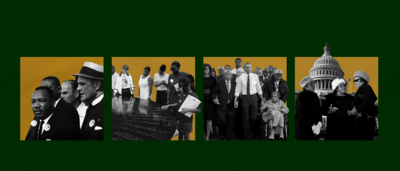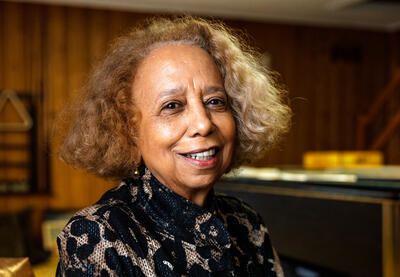Valda Harris Montgomery witnessed pivotal moments of the Civil Rights Movement in Montgomery, Alabama. In this excerpt from her 2023 interview with Learning for Justice, Montgomery emphasizes the importance of learning the honest history of the movement.
The Montgomery Bus Boycott
My eighth birthday was Dec. 1, 1955, which also happened to be the day that Rosa Parks refused to give up her seat. … When people are chattering about this event that’s going on, you’re hearing your parents and their friends mumbling, and I’m thinking they’re planning this party for me – that I’m going to be 8. Only to find out, no, that this is about the birth of the modern Civil Rights Movement.
Being so close with Martin Luther King and Mrs. King – they were our neighbors, just right down the street, and they were close family friends. So, you know, of course, we are talking and playing with their children, and you’re involved with the neighbors because this is a segregated neighborhood.
So, you’re watching – and the bus that comes right in front of the house – and watching that very first day, December 5, when they asked them not to ride the bus, and watching all of the neighbors on their porches, cheering because nobody was on the bus on that Monday. … We’re cheering because they’re cheering, not really understanding what this is about. … From that point on, [we] watch people actually stay off the bus, the 381/382 days. The solidarity of a group of people is something I witnessed, and I don’t think I’ve ever seen again.
The Freedom Riders
When the Freedom Riders came to Montgomery … that was the leg from Nashville that was going to pick up after the bombing in Anniston, Alabama.
Now, these people are 18, 19 and 20 years of age, and they are students. Reverend James Lawson had trained them all in the nonviolent method. And so they were ready because they had already done the lunch counters and had already done the department stores and everything.
So, when they managed to get through Birmingham and came to Montgomery and were so badly attacked at the Greyhound bus station and dispersed and regrouped at Reverend Abernathy’s church, and this mob surrounds the church. They are technically held hostage with the same 1,500 or so congregants that were there as well – for a prescheduled mass meeting with the leaders there, as well.
So, Martin Luther King goes into the basement, makes contact with Robert Kennedy, who was our attorney general at the time, to please send the National Guard to help get these people out of the church, because the mob is throwing tear gas and everything. … The National Guard comes and loads the Freedom Riders onto the trucks, and they bring them here.
I was 13 years old, 4 o’clock in the morning, watching them come down the hallway into the kitchen, bloodied, battered and beaten.
Most of the time when you hear the story of the Freedom Rides in Montgomery, you hear about the attack at the church and the next thing you know, they’re on a bus headed to Jackson. But there was like a three- or four-day window that they’re in Montgomery and nobody knew – well, where were they?
They were here in [this] house. … [Harris family house in Montgomery, Alabama]. That was something that I got a chance to witness. To see them so casually having fun and yet getting ready to put their life out on the line and where they’re about to head to Jackson, Mississippi. You just sit and you listen to them, and, you know, you laugh, but you also listening at the same time.
Message to Young People
Some of the students that I have spoken with, especially during the times of George Floyd … [said]: “I’m feeling this anger. I just want to do something.” I said, “Well first, don’t lose the feeling, but change the word to ‘passion’ instead of ‘anger.’” I said, “Don’t lose that feeling, because that’s going to drive you forward.” But you’ve got to organize, and you’ve got to organize with like-minded people … You’ve got to have differences of opinion, because you want to hear everybody’s point of view in order to move forward.
Look at the actual documentaries from people instead of the Hollywood movies. … People that have lived it are looking at these movies like, “No, that didn’t happen.” And just a slight change will tweak history, much like being taught that Rosa Parks sat in the front of the bus, and she did not. She sat in front of the Black section of the bus. Well, when you take out those two words, you’ve distorted history. And so, if they watch the actual documentaries like Eyes on the Prize or like Freedom Riders, or those that you’re seeing the actual footage of these people – these are not actors. That’ll help you to learn that we’re not making this up.
Just a Neighbor
In her memoir, Valda Harris Montgomery shares memories of growing up during the Civil Rights Movement.
You know, this is what happened, and when you’re saying, “But that was so long ago because it was black-and-white footage,” I’m talking to you, OK? It wasn’t that long ago. It just happened to be filmed in black-and-white, but it was during my lifetime. That means it was not that long ago that all of this happened.
Reflection and Action
- Valda Harris Montgomery encourages us to learn from the past by looking at actual documentaries and the words of those who lived these experiences. She warns us to be conscious of how historical details might be altered in the media. Learn more in the LFJ learning journey Media Literacy Is Vital During the Election Process and use the recommendations to practice analyzing and evaluating information for accuracy and reliability.
- Reflect on how emotions guide your daily decisions and actions. Think about and discuss with others how our emotions can be manipulated by political campaigns and media, especially around certain topics.
- Participate in or organize a book club in your community. Choose books about contemporary or historical issues that affect your life today. Use this depth of understanding to look deeper into how media approaches various issues. Use these connections as points for discussion with others. LFJ’s Liberation Lit book reviews for adults, youth and children is a good starting point for reading and discussion.
Interviews by Crystal Keels, Ph.D. (she/her), LFJ’s analyst for learning content, and Jacob Saylor (he/him), SPLC’s senior video producer.

Learning from the Civil Rights Movement
The Civil Rights Movement is a story of people who believed they could bring about change. The learning journeys and resources in this series can help us learn from our history and examine today’s justice issues to answer the questions: “How can I make a difference?” “How can we make a difference together?”
